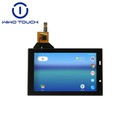First, let's deal with the elephant in this article or least the touchscreen that seems to be suffering from elephantitus. We won't deny it, when we first saw the Tesla's huge 17-inch touchscreen, it looked ridiculous.

It's almost as if Tesla took a blasé bigger-is-better approach and simply slapped a large PC monitor into the dash. If anything, the incongruity of finding such a large screen in-car makes it look even bigger than 17 inches. It's massive.
Then there's the question of how practical a capacitive touchscreen is in an automotive context. There's a school of thought in the industry that says capacitive screens are a bit sensitive, a bit flighty for cars. A nice deliberate resistive screen that needs a good, hard prod is what you need.
Then there are issues like, ergonomics, tactility and physical feedback. At the very least, the jury is out on touch. Some major manufacturers like Audi and BMW prefer wheel-based inputs while others, including VW, go with touchscreens.
However, even the touchscreen camp has kept the functionality on-screen strictly limited. Conventional physical controls for a wide range of functionality typically remain.
But not in the Model S. Tesla has ditched almost every physical button and control. There's a steering wheel with some short-cut keys, buttons for the windows, a hazard light switch and a button to release the glove box lid. And that's it.
Yes, really. Literally everything else from the climate control to the suspension settings and even the sunroof is controlled via virtual menus on the touchscreen. Again, we have no problem admitting that, on paper, this sounds like a very bad idea.




